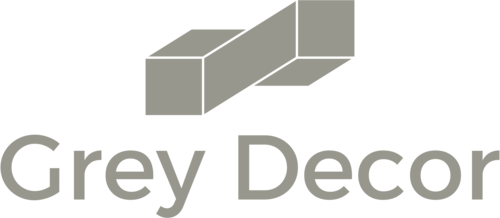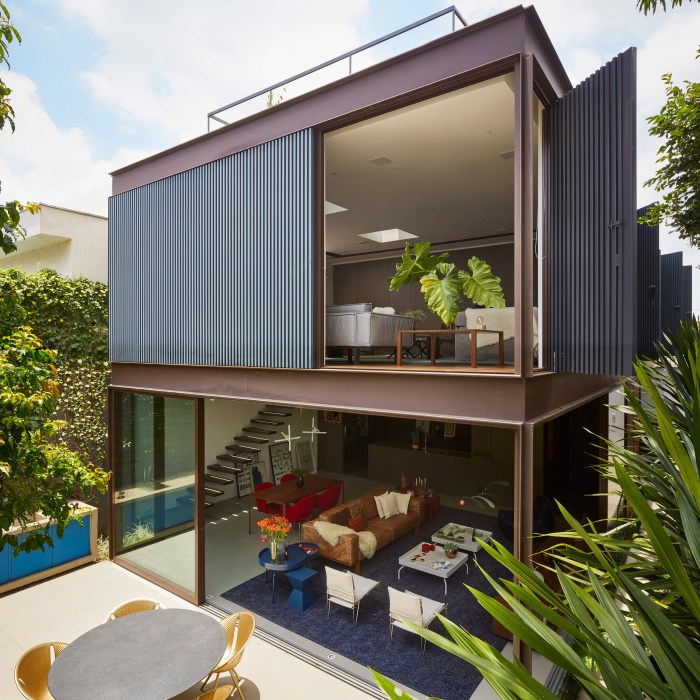Box House Interior Design: A Modern Minimalist Approach
Box house interior design embraces a minimalist aesthetic, prioritizing clean lines, open spaces, and a sense of tranquility. These homes, often characterized by their geometric forms and lack of ornamentation, offer a unique canvas for creating stylish and functional interiors.
The appeal of box houses lies in their ability to seamlessly blend modern architecture with a contemporary lifestyle, attracting those who value simplicity, functionality, and a touch of sophistication.
This guide explores the essential elements of box house interior design, from layout planning and color palettes to furniture selection and lighting techniques. We delve into the principles of space optimization, natural light utilization, and sustainable design considerations, offering practical tips and inspiring examples to help you create a truly captivating box house interior.
Lighting and Ambiance
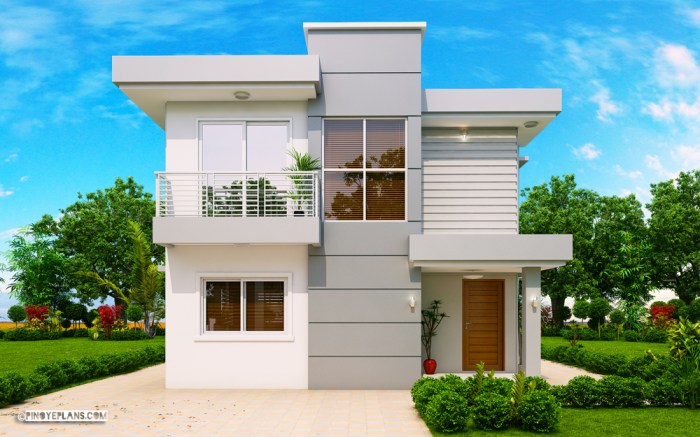
Lighting plays a crucial role in shaping the atmosphere and functionality of a box house interior. By strategically incorporating natural and artificial light sources, you can create a dynamic and inviting space that highlights architectural features and enhances the overall aesthetic.
Natural Light Integration
Maximizing natural light is essential in a box house, where limited windows can create a sense of enclosure. Consider incorporating large windows or skylights to flood the interior with daylight. These openings can be strategically positioned to maximize sunlight penetration and create a bright and airy feel.
- Maximize Window Placement:Position windows on multiple sides of the house to allow for cross-ventilation and ample natural light.
- Skylights for Depth:Skylights can be used to illuminate specific areas or create a dramatic effect, adding depth and visual interest.
- Light Reflecting Surfaces:Use light-colored walls and furniture to reflect natural light and enhance the overall brightness.
Artificial Lighting Techniques, Box house interior design
Artificial lighting plays a crucial role in complementing natural light and creating different moods. A well-designed lighting plan should incorporate a combination of ambient, task, and accent lighting.
- Ambient Lighting:Provides general illumination and creates a sense of warmth and coziness. This can be achieved through overhead fixtures, such as chandeliers or recessed lights.
- Task Lighting:Focuses light on specific areas where activities take place, such as reading nooks, workspaces, or kitchen counters.
Desk lamps, under-cabinet lighting, and pendant lights are effective task lighting options.
- Accent Lighting:Highlights specific architectural features, artwork, or decorative elements. This can be achieved using track lighting, spotlights, or wall sconces.
Lighting for Mood Creation
Lighting can significantly impact the overall ambiance of a box house interior. By manipulating light temperature and intensity, you can create a variety of moods and atmospheres.
- Warm White for Intimacy:Warm white light (2700-3000K) creates a cozy and intimate atmosphere, making it ideal for living rooms and bedrooms.
- Cool White for Focus:Cool white light (4000-4500K) is more stimulating and ideal for workspaces, kitchens, or areas where concentration is needed.
- Dimmable Lighting:Using dimmers allows you to adjust the intensity of lighting to create different moods, from bright and energetic to soft and romantic.
Impact of Lighting on Box House Interiors
Lighting can transform the feel of a box house interior, creating a sense of spaciousness, depth, and warmth.
- Visual Expansion:Well-placed lighting can make a small space feel larger by highlighting specific areas and drawing the eye upwards.
- Architectural Emphasis:Accent lighting can highlight architectural features, such as exposed beams or unique wall treatments, creating visual interest and adding character.
- Enhanced Aesthetics:Strategic lighting can enhance the beauty of furniture, artwork, and other decorative elements, creating a visually appealing and inviting space.
Sustainable Design Considerations
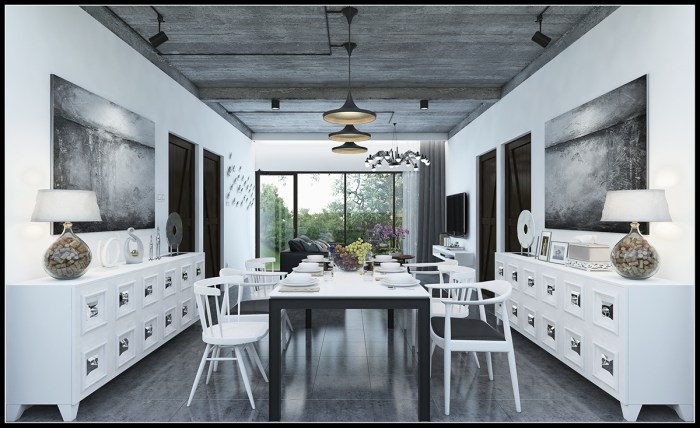
Box houses, with their minimalist aesthetic and emphasis on functionality, offer a unique opportunity to incorporate sustainable design principles. By prioritizing eco-friendly materials, energy-efficient technologies, and responsible practices, these homes can minimize their environmental impact while enhancing occupant well-being.
Sustainable Materials
The use of sustainable materials is a cornerstone of responsible design in box houses. These materials are sourced and manufactured in a way that minimizes environmental harm and promotes resource conservation.
- Recycled and Upcycled Materials:Incorporating recycled materials like reclaimed wood, salvaged bricks, and repurposed metal not only reduces waste but also adds character and a unique story to the interior design.
- Locally Sourced Materials:Choosing materials from local suppliers reduces transportation emissions and supports local economies.
This can include wood from nearby forests, stone from regional quarries, or even recycled materials from local businesses.
- Natural Materials:Opting for natural materials like bamboo, cork, and wool promotes a healthy indoor environment. These materials are renewable, biodegradable, and often have excellent thermal insulation properties.
Energy-Efficient Appliances and Lighting
Box houses can be designed to optimize energy efficiency through the careful selection of appliances and lighting solutions.
- Energy-Star Rated Appliances:Choosing appliances with Energy Star certification ensures they meet specific energy-efficiency standards. This includes refrigerators, dishwashers, washing machines, and dryers, which can significantly reduce energy consumption.
- LED Lighting:LED lighting is highly energy-efficient and long-lasting, reducing electricity consumption and minimizing the need for frequent bulb replacements.
- Smart Home Technology:Integrating smart home systems allows for automated control of lighting, heating, and cooling, enabling optimization based on occupancy and weather conditions.
Sustainable Design Features
Box houses often incorporate sustainable design features that enhance energy efficiency and reduce environmental impact.
- Passive Solar Design:Strategically placed windows and skylights can maximize natural light and heat gain during winter, reducing reliance on artificial lighting and heating.
- Green Roofs:Installing a green roof, covered with vegetation, provides insulation, reduces stormwater runoff, and enhances the visual appeal of the home.
- Rainwater Harvesting:Implementing rainwater harvesting systems collects and stores rainwater for non-potable uses like irrigation and flushing toilets, reducing reliance on municipal water supplies.
Box House Interior Design Styles
Box houses, with their simple, geometric forms, provide a blank canvas for a variety of interior design styles. The minimalist nature of the architecture allows for a focus on the details that create a specific aesthetic. Let’s explore some popular styles that are particularly well-suited for box houses.
Modern Minimalist
Modern minimalist style embraces clean lines, open spaces, and a neutral color palette. It prioritizes functionality and simplicity, creating a sense of calm and tranquility. This style typically features:
- A limited use of colors, often sticking to white, gray, black, and natural wood tones.
- Minimalist furniture with sleek lines and simple shapes.
- Natural materials like wood, stone, and metal.
- Large windows to maximize natural light and create a sense of openness.
Examples of modern minimalist box house interiors often feature:
- A white sofa with a simple throw blanket, placed against a backdrop of white walls and large windows.
- A dining table made of natural wood with minimalist chairs, surrounded by a geometric rug.
- A kitchen with sleek cabinetry and countertops made of stone or stainless steel.
Scandinavian
Scandinavian style is known for its warmth, functionality, and natural materials. It emphasizes simplicity and practicality, creating a cozy and inviting atmosphere.This style typically features:
- A light and airy color palette, often using white, gray, and pastel shades.
- Natural materials like wood, wool, and leather.
- Simple, functional furniture with clean lines.
- A focus on natural light and a connection to the outdoors.
Examples of Scandinavian box house interiors often feature:
- A white sofa with soft, wool throws, placed in front of a large window with a view of nature.
- A wooden dining table with simple chairs, surrounded by a light-colored rug.
- A kitchen with white cabinets and a wooden countertop, featuring a natural light source.
Industrial
Industrial style is characterized by its raw, exposed elements and a blend of vintage and modern pieces. It embraces a sense of history and authenticity, creating a unique and edgy atmosphere.This style typically features:
- A neutral color palette with accents of metal and wood.
- Exposed brick walls, concrete floors, and metal beams.
- Vintage furniture with a distressed finish.
- Industrial lighting fixtures, such as pendant lights or track lighting.
Examples of industrial box house interiors often feature:
- A leather sofa with a distressed finish, placed against a backdrop of exposed brick walls.
- A metal dining table with vintage chairs, surrounded by a concrete floor.
- A kitchen with exposed ductwork and stainless steel appliances.
Final Conclusion: Box House Interior Design
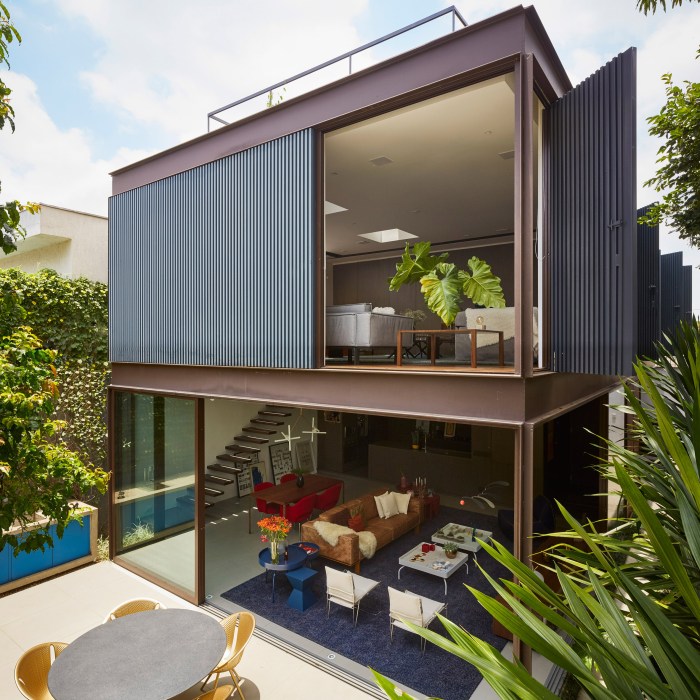
Designing a box house interior is a journey of balancing form and function, embracing minimalism while incorporating personal touches. By understanding the unique characteristics of this architectural style and applying the principles Artikeld in this guide, you can transform your box house into a haven of modern elegance, comfort, and individuality.
Remember, the key to a successful box house interior lies in creating a harmonious balance between the architectural structure and the personal style of its inhabitants.
FAQ
What are the benefits of a box house interior design?
Box house interiors offer several benefits, including a spacious and airy feel, enhanced natural light, and a minimalist aesthetic that promotes a sense of calm and order.
How do I incorporate personal touches into a box house interior?
While maintaining the minimalist aesthetic, you can add personal touches through artwork, photography, plants, and unique furniture pieces that reflect your individual style.
What are some common challenges of designing a box house interior?
Challenges can include maximizing limited space, ensuring adequate natural light, and creating visual interest within a minimalist framework.
